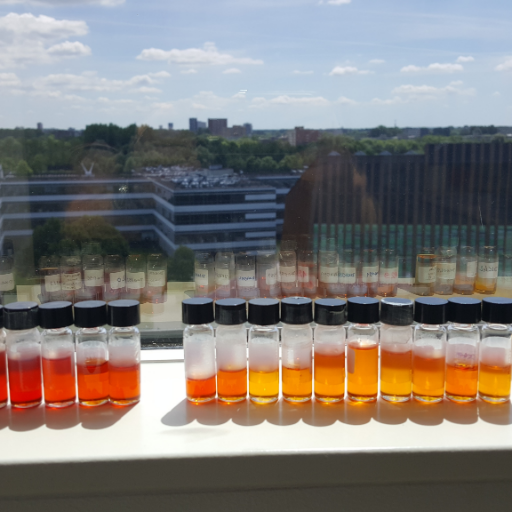
Roelfes Group (find us as @roelfesgroup on BS)
@RoelfesGroup
Followers
2K
Following
215
Media
72
Statuses
202
Inactive account. Follow us on Bluesky.
Groningen, Nederland
Joined November 2018
We would like to inform our followers and colleagues that our #X account will no longer be active. Henceforth we will share all the updates from the group and discuss amazing science with you on #Bluesky. Find us there as @roelfesgroup.bsky.social.
0
0
2
📢📢📢The ML-GUIDE team (@fra_grisoni, @robpollice and myself) are looking for 3 PhD students, passionate about combining the directed evolution of diverse biomolecules with deep learning approaches to develop better (bio)catalysts and drugs! Pls retweet https://t.co/lh3z4RUTeJ
0
13
23
Exciting PhD opportunities coming soon in the EVOLVE consortium! 🚀 Focus: origins of molecular chirality & prebiotic chemistry. 🧪 Seeking motivated students in organic synthesis, stereochemistry, or supramolecular chemistry. 🌟 https://t.co/V7jN98HqCv
https://t.co/OIZUIMZcm1
evolve-programme.eu
Current theory holds that, during the early stages of chemical evolution, microscopic compartments called protocells played a critical role, because they were able to sequester and concentrate small...
3
24
91
Delighted to announce that 'Engineered enzymes for enantioselective nucleophilic aromatic substitutions' is out now in Nature! Congratulations to Tom, George and everyone else involved in this project! 🎉🎉🎉 https://t.co/qnrNLXLhbw
nature.com
Nature - A biocatalytic approach to enantioselective nucleophilic aromatic substitution (SNAr) was achieved through laboratory evolution of highly efficient and selective SNArase biocatalysts.
0
14
70
Check out our latest work where we combined mutagenesis, crystallography, and computational approaches to uncover the evolutionary specialization of a promiscuous designer enzyme. Kudos to @reubenlg and the entire team! Find more details in the thread below:
Very happy to see that our latest paper just appeared online in @ACSCatalysis. https://t.co/jrNSUI8qRY
0
0
13
A good start to the new year: I was awarded the Postdoc Prize 2024 of the Faculty of Science and Engineering in Groningen! Very happy to receive this award to recognize my achievements in the @RoelfesGroup ! Now, I am looking for a new adventure!
2
1
33
Fantastic start of 2025 for the group. Our own @Longlarf won the @univgroningen FSE Postdoc prize for 2024. This prize celebrates his excellence in research and great potential of becoming a scientific leader. Well well deserved Lars! 👏 @StratinghInst
0
2
31
Season's greetings from Roelfes and Mayer @narf42 groups! Wishing our colleagues, collaborators, and the entire community a joyful holiday season and a prosperous New Year ahead! 🎉🎄✨🧪
1
4
20
Artificial Gold Enzymes Using a Genetically Encoded Thiophenol-Based Noble-Metal-Binding Ligand (Gerard Roelfes and co-workers) @RoelfesGroup #openaccess 🔓
onlinelibrary.wiley.com
A new class of artificial metalloenzymes containing genetically encoded noble-metal-binding sites featuring a non-canonical thiophenol-based amino acid, which serves as an excellent soft ligand for...
0
6
22
🥳🥳🥳 Early Christmas Present for @fra_grisoni @robpollice and me! @NWOFunding awarded us €2.7 million for our NWO-XL grant "ML-GUIDE – Machine Learning-GUIded Directed Evolution for drug discovery and (bio)catalyst engineering"! Best! Consortium! Ever! https://t.co/AmMMuEAzv1
nwo.nl
21 research consortia have the chance to reach a breakthrough thanks to funding from the Open Competition Domain Science - XL. From fundamental research on the effects of certain materials on the...
2
3
44
Congratulations to Mathijs @MathijsV1, Friso @FrisoAalbers, Henriette, Andy, and Daniel @DFS_Chemistry for the amazing results! @StratinghInst @univgroningen
0
0
5
Homoleptic transition metal complexes using thiolates are rare due to their propensity to form aggregates. The spatial separation of the thiol ligands circumvented this problem and demonstrates thiophenols as an attractive ligand in noble-metal catalysis.
1
0
4
We characterised the corresponding thiophenol-based gold(I) enzyme with several techniques, including X-ray crystallography, that confirm the binding of the gold to the thiophenol and applied it in new-to-nature hydroamination reactions. https://t.co/kHaKj7Lk8a
1
0
3
The genetic incorporation of a thiophenol-based amino acid (pSHF) was developed! Introducing pSHF expands the amino acid repertoire for stop-codon suppression with a versatile amino acid. We leveraged pSHF for binding a variety of noble metals to LmrR.
1
0
2
We are thrilled to share our new noble-metal enzyme design approach. We used the in-vivo incorporation of a noble-metal-binding ligand for ArM design to bridge the versatility of noble metals with the catalytic power of enzymes. Thread ⬇️
1
17
106
Boron Designer Enzyme with a Hybrid Catalytic Dyad (@RoelfesGroup): https://t.co/y9DBDYxteD (@ACSCatalysis).
0
4
18
https://t.co/LWW4XhkhMf Congratulations to Lars @longlarf, Marijn, Bart @BartBrouwer7 and Andy-Mark for the endeavor!
pubs.acs.org
Genetically encoded noncanonical amino acids can introduce new-to-nature activation modes into enzymes. While these amino acids can act as catalysts on their own due to their inherent chemical...
0
1
6
We are delighted to introduce our new Boron Designer Enzyme for the kinetic resolution of α-hydroxythioesters. For this activity, the noncanonical amino acid and a natural lysine residue have to work together to form a Hybrid Catalytic Dyad!
1
8
80
If you are new to the field of artificial metalloenzymes or simply want to know where things stand, check out our new primer on the topic @MethodsPrimers
https://t.co/3h1c9WlsvZ
nature.com
Nature Reviews Methods Primers - Artificial metalloenzymes harness metal cofactors that are not naturally found in enzymes and embed these in specifically selected or designed protein scaffolds. In...
3
11
49
BREAKING NEWS The Royal Swedish Academy of Sciences has decided to award the 2024 #NobelPrize in Chemistry with one half to David Baker “for computational protein design” and the other half jointly to Demis Hassabis and John M. Jumper “for protein structure prediction.”
514
9K
20K















